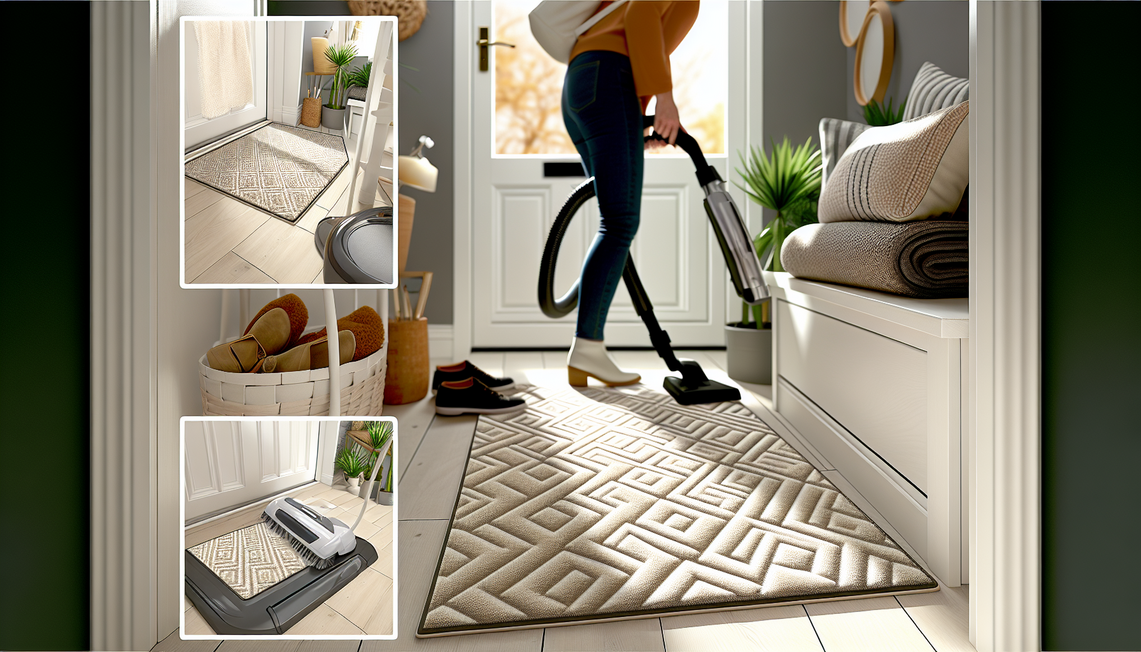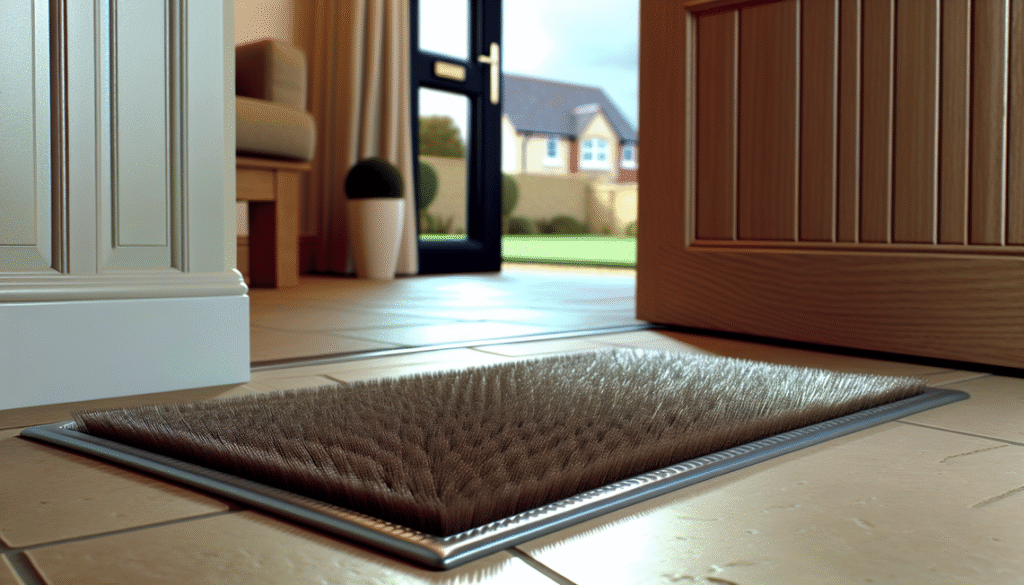Maintaining a clean and effective washable dirt trapper doormat is essential for keeping your home spotless, hygienic, and welcoming. These practical entrance mats are designed to be the first line of defence against outdoor mess, preventing mud, grit, and debris from spreading indoors. This comprehensive guide covers everything you need to know about caring for your dirt trapper mat, ensuring it stays fresh, durable, and highly efficient at protecting your flooring year-round.
Why Choose a Washable Dirt Trapper Doormat for Your Home?
Washable dirt trapper mats offer a multitude of benefits that extend beyond simply keeping your floors clean. Their unique design and materials make them an indispensable addition to any entryway.
Benefits of Using Washable Dirt Trappers
Washable dirt trapper mats are specifically engineered to capture mud, grit, moisture, and fine dust particles right at your doorstep. This proactive approach prevents dirt from being tracked further into your home, significantly reducing the amount of cleaning required for your interior floors. The key advantage is their washable nature, which means you can clean them easily, restoring their original effectiveness and pristine appearance without the need for frequent replacements. This not only offers long-term cost savings but also promotes a healthier indoor environment by significantly reducing the build-up of allergens, bacteria, and dust mites.
How Washable Mats Protect Your Home and Improve Cleanliness
Deploying a washable dirt trapper doormat at your entrance acts as a crucial barrier against outside mess. By trapping dirt early, these robust mats help to preserve the integrity and longevity of your internal flooring, whether it’s carpet, laminate, wood, or tiles. They reduce the frequency of thorough cleaning required inside the house and maintain a healthier, more aesthetically pleasing indoor environment. This is particularly beneficial in high-traffic areas, busy family homes, or residences with children and pets, where maintaining cleanliness is a constant challenge. Their non-slip backing also adds an extra layer of safety, preventing slips and trips on wet or muddy surfaces.
Getting to Know Your Washable Dirt Trapper: Materials & First Steps
Understanding the construction of your washable entrance mat is key to providing it with the best possible care and ensuring its long-term performance.
Understanding Common Fabrics and Backing Types
Most washable dirt trapper mats, especially those designed for heavy use, feature durable, high-performance synthetic fibres such as nylon, polypropylene, or polyester. These materials are chosen for their excellent dirt-trapping capabilities, absorbency, and resistance to wear and tear. The textured surface of the pile is expertly designed to scrape dirt and moisture from shoes effectively. Crucially, these mats are typically combined with a robust non-slip backing, often made from rubber or latex. This backing ensures the mat stays securely in place, preventing movement and reducing trip hazards, while also protecting your underlying floors from moisture damage.
Preparing Your Mat for Its Initial Wash
Before putting your new washable dirt trapper mat into use, it’s wise to take a few preparatory steps. Begin by giving the mat a good shake outdoors to dislodge any loose fibres or manufacturing dust. Always consult the care label provided by the manufacturer, as specific washing instructions can vary. Some mats may benefit from a gentle pre-wash to help set the fibres, improve absorbency, and optimise their dirt-trapping performance from the outset. During this initial cleaning, it’s particularly important to avoid using any harsh chemicals, as these could potentially damage the fibres or the non-slip backing.
Effective Daily and Weekly Care for Longevity
Regular, proactive care is the simplest way to maintain the effectiveness and extend the lifespan of your washable dirt trapper doormat.
Vacuuming Techniques to Remove Surface Dirt
One of the easiest and most effective daily or weekly maintenance tasks is vacuuming. Use a sturdy vacuum cleaner, ideally with a brush attachment, to efficiently remove loose dirt, dust, and debris that accumulates on the mat’s surface. Regular vacuuming prevents these particles from becoming deeply embedded within the fibres. For optimal results, vacuum both sides of the mat – the pile side to remove trapped dirt and the backing side to clean any dust or debris that might have settled underneath, which also helps preserve the non-slip properties.
Smart Maintenance Habits to Extend Cleanliness
- Shake it Out Daily: Take your mat outdoors and give it a vigorous shake to dislodge any loose soil, grit, or leaves trapped in the fibres. This simple action prevents accumulation and keeps the mat looking tidier.
- Spot Clean Spills Immediately: Accidents happen. Address any spills or wet spots immediately by blotting with a clean cloth and a mild detergent solution. Quick action prevents stains from setting and becoming more difficult to remove.
- Protect from the Elements: Whenever possible, position your mat in a covered porch or entryway. This reduces its exposure to extreme weather conditions like heavy rain, prolonged direct sunlight, or snow, which can degrade fibres and backing over time.
Common Mistakes to Avoid During Regular Use
To ensure your washable dirt trapper mat performs optimally and lasts for years, be mindful of these common pitfalls:
- Dragging Forcefully: Avoid dragging the mat roughly across abrasive surfaces. This can snag, pull, or damage the fibres, compromising its effectiveness and appearance.
- Excessive Wetting of Backing: While the backing is designed to be durable, try to avoid unnecessary or prolonged wetting of the underside. Constant dampness can, over time, degrade the non-slip grip of the rubber or latex, and may also promote mould growth on your floor if left unchecked.
- Overloading: Do not place excessively heavy items on the mat for extended periods. This can compress the fibres, reducing their ability to trap dirt and potentially deforming the mat’s pile.
Step-by-Step Guide to Deep Cleaning Your Doormat
When daily vacuuming and shaking are no longer enough, a deep clean will restore your mat’s full dirt-trapping efficiency and freshness.
Preparing Your Mat Before Deep Cleaning
Before any deep cleaning process, it’s crucial to prepare your mat. Take the mat outside and give it a thorough shake to remove as much loose dirt, dust, and debris as possible. For any stubborn particles or dried mud that cling to the fibres, gently brush them off using a soft-bristle brush. This preliminary step ensures that you’re not just moving dirt around during the wash, making the deep cleaning process much more effective.
Hand Washing Method: Tools and Best Practices
Hand washing is an excellent option for delicate mats, smaller mats, or when you want precise control over the cleaning process:
- Prepare Your Solution: Fill a large bucket, basin, or bathtub with warm water (not hot) and add a small amount of mild, pH-neutral detergent. Avoid harsh chemicals, bleach, or fabric softeners, as these can damage the mat’s fibres and backing.
- Submerge and Scrub: Carefully submerge the mat into the soapy water. If the mat is too large to submerge fully, work on sections. Use a soft sponge or a gentle brush to lightly scrub the surface of the mat, focusing on heavily soiled areas. Apply gentle pressure to avoid damaging the fibres.
- Rinse Thoroughly: Drain the dirty water and rinse the mat meticulously with clean, cool water. Continue rinsing until all traces of soap residue are completely removed. Any leftover soap can attract dirt more quickly and leave the mat feeling sticky.
- Gentle Water Removal: Do not aggressively wring or twist the mat, as this can deform its shape and damage the rubber backing. Instead, gently press out excess water, or roll the mat tightly to squeeze water out.
How to Machine Wash Your Washable Dirt Trapper Safely
Many modern dirt trapper mats are designed to be machine washable, offering a convenient way to deep clean. However, it’s vital to follow specific guidelines to prevent damage.
Recommended Temperature Settings and Cycles
When machine washing, always use a cold or warm water setting, typically no higher than 30°C. This lower temperature protects the integrity of the mat’s fibres and, more importantly, prevents the rubber or latex backing from degrading, cracking, or losing its non-slip properties due to excessive heat. Select a gentle or delicate cycle to minimise agitation, which can otherwise cause excessive wear and tear on the mat.
Essential Washing Guidelines to Prevent Damage
- Detergent Choice: Steer clear of bleach, fabric conditioners, or harsh, abrasive detergents. These can strip the mat’s protective coatings, weaken fibres, and damage the non-slip backing. Opt for a mild, pH-neutral liquid laundry detergent.
- Wash Separately: To prevent potential snagging and to ensure the mat gets a thorough clean, wash it alone or with similar, non-linting items. This also prevents dirt from the mat transferring onto other laundry.
- Machine Capacity: Ensure your mat fits comfortably inside your washing machine drum without being overly crammed. Overloading can prevent proper cleaning, cause excessive friction, and potentially deform the mat or strain your washing machine.
When and How to Opt for Professional Power Washing
For heavily soiled industrial dirt trapper mats, or commercial entrance mats that endure extreme foot traffic and dirt, professional power washing services can be an excellent option. These services use specialised equipment and cleaning agents designed to tackle ingrained grime without damaging the mat’s structure. A professional cleaner can effectively restore the mat’s cleanliness and dirt-trapping efficiency, often extending its operational lifespan, making it a worthwhile investment for businesses or exceptionally dirty residential mats.
Proper Drying Techniques to Preserve Durability
Drying your washable dirt trapper doormat correctly is just as important as washing it correctly to ensure its longevity and performance.
Advantages of Air Drying Your Doormat
Air drying is generally the safest and most recommended method for washable dirt trapper mats. Lay the mat flat in a well-ventilated area, either indoors or outdoors, ensuring good airflow. This method helps the mat maintain its original shape and prevents any potential heat damage to the fibres or, critically, the rubber backing. Avoid direct, prolonged exposure to strong sunlight, which can cause colours to fade over time and may degrade the rubber backing material, making it brittle or sticky.
Safe Tumble Drying Practices
If your mat’s care label specifically states that tumble drying is safe, proceed with caution. Always use the lowest heat setting available on your dryer. High heat is the primary enemy of rubber-backed mats and can cause shrinking, cracking, or melting of the backing. To help fluff the fibres and encourage even drying, you can include a couple of clean tennis balls in the dryer. Monitor the mat closely and remove it as soon as it is dry to prevent unnecessary heat exposure.
Avoiding Damp Floor Damage – Key Tips
It is absolutely crucial to ensure your washable mat is *completely dry* before you place it back on your floor, especially if it has a rubber or latex backing. Placing a damp mat on your floor for an extended period can lead to several problems: it can trap moisture, potentially damaging wooden floors, discolouring carpets, or promoting the growth of mould and mildew underneath, which can produce unpleasant odours and pose health risks. Always err on the side of caution and allow extra drying time if needed.
Maintaining Optimal Performance Throughout the Year
Consistent care ensures your dirt trapper mat continues to provide maximum protection and cleanliness for your home, regardless of the season.
Caring for Rubber Backing to Prevent Wear
The rubber or latex backing is vital for keeping your mat securely in place and protecting your floors. To maintain its integrity, periodically lift the mat and wipe down the underside with a damp cloth to remove any accumulated dust or debris. This also helps to revitalise its non-slip grip. Crucially, avoid using any oil-based cleaners, strong solvents, or harsh chemicals on the backing, as these can cause the rubber to dry out, crack, or become sticky and ultimately degrade its performance.
Rotating Your Doormat for Even Use and Longevity
Areas of an entrance mat that experience higher foot traffic will naturally show wear faster. To distribute this wear more evenly and significantly extend the overall lifespan of your mat, simply rotate it 180° every few weeks or once a month. This small adjustment ensures that all parts of the mat are subjected to similar levels of use, delaying fibre breakdown and maintaining a consistent appearance across the mat’s surface.
Seasonal Care Tips: Winter and Summer Adjustments
Your dirt trapper mat will face different challenges throughout the year, requiring slight adjustments to its care routine:
- Winter Care: During the colder, wetter months, your mat will contend with more mud, slush, road salt, and grit. Increase the frequency of shaking and vacuuming. Promptly brush off any salt or abrasive grit, as these can be particularly damaging to fibres. Consider having a second, perhaps heavier-duty outdoor mat to trap the worst of the elements before visitors reach your washable indoor mat.
- Summer Care: In drier conditions, your mat will primarily collect dust, sand, and pollen. Regular shaking and vacuuming are key. If your mat is exposed to direct sunlight, occasionally check for signs of sun damage or fading, and try to reposition it or provide shade if possible to preserve its colours and backing.
Troubleshooting Common Problems with Washable Dirt Trappers
Even with the best care, sometimes issues arise. Here’s how to tackle them effectively.
Removing Stubborn Stains Effectively
For more stubborn stains, quick action is essential. Start by blotting any liquid spills with a clean cloth. For dried stains, gently scrape off any excess material. Then, apply a gentle, pH-neutral stain remover specifically designed for carpets or upholstery, or make a paste using baking soda and a small amount of water. Apply the paste to the stain with a soft brush, let it sit for a few minutes, then gently scrub. Rinse the treated area thoroughly with clean water afterwards and blot dry to remove all residue. Always test any stain remover on an inconspicuous area first.
Managing Odours for a Fresh Smell
Over time, mats can absorb odours, especially in homes with pets or if exposed to dampness. To neutralise unpleasant smells, generously sprinkle dry baking soda (bicarbonate of soda) over the entire surface of the mat. Allow it to sit for a few hours, or even overnight, to absorb the odours. Afterwards, simply vacuum the mat thoroughly to remove the baking soda, leaving your mat smelling much fresher. For persistent odours, a deep clean followed by proper drying is recommended.
Solutions for Loss of Dirt-Trapping Efficiency
If your mat seems to be losing its ability to trap dirt effectively, it’s often due to flattened fibres or embedded grime. A thorough deep clean (either hand washing or machine washing) can often revitalise the fibres. After cleaning, ensure proper air fluffing during the drying process to help restore the pile. If, however, the mat’s fibres are permanently matted down, or if the rubber backing starts to peel, crack, or become excessively sticky, it’s a clear sign that the mat has reached the end of its effective lifespan. At this point, for safety and performance reasons, it is advisable to consider replacing the mat.
For a reliable, heavy-duty washable dirt trapper doormat designed to keep your home clean and safe year-round, consider the RugStars Heavy Duty Dirt Trapper Doormat. Its durable materials and advanced non-slip backing make maintenance straightforward while providing excellent dirt and moisture removal.
Frequently Asked Questions About Washable Dirt Trapper Doormat Care
Here are answers to some common questions regarding the cleaning and maintenance of your washable dirt trapper mat.
How often should I wash my washable dirt trapper doormat?
For optimal hygiene and performance, washing your washable dirt trapper doormat every 1-2 months is generally recommended. This should be complemented by frequent vacuuming and shaking between washes to remove surface dirt and maintain its effectiveness.
Can I use bleach or harsh chemicals safely on my dirt trapper mat?
No, it is strongly advised against using bleach or harsh chemicals. These can severely damage the mat’s fibres, compromise the integrity of its non-slip backing, and lead to discolouration. Always opt for mild, pH-neutral detergents.
What should I do if the rubber backing of my mat starts to peel or crack?
If the rubber backing begins to peel, crack, or become brittle, it’s a sign that the mat is deteriorating. Discontinue use immediately to prevent slipping hazards. At this point, the mat can no longer offer its intended safety or floor protection, and it is best to replace it.
Is machine drying safe for all types of washable dirt trappers?
Not always. While some mats are designed for machine drying, many, particularly those with rubber backing, are best air-dried to prevent heat damage. Always check the specific care label provided by the manufacturer. If tumble drying is permitted, use the lowest heat setting.
How can I extend the lifespan of my washable dirt trapper doormat?
To maximise the lifespan of your washable dirt trapper doormat, implement regular cleaning practices, use appropriate washing and drying techniques, rotate the mat periodically to distribute wear, and protect it from excessive exposure to harsh weather conditions and direct sunlight.
By following this comprehensive care guide, your washable dirt trapper doormat will remain an effective, long-lasting gateway protector, enhancing your home’s cleanliness, safety, and overall welcoming appeal for many years to come.



